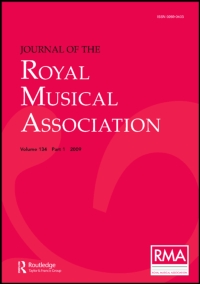No CrossRef data available.
Article contents
On Standards of Musical Pitch
Published online by Cambridge University Press: 01 January 2020
Extract
Dr. Stone said he did not intend to go into the question of any particular pitch, but rather to deal with the difficulties of keeping to a pitch when it was obtained. This was a constant source of difficulty, particularly in orchestras, where the wood instruments were constantly varying. In almost all cases the pitch tended upwards. The process of ascertaining with exactness the number of vibrations per second, either by means of the siren or any other instrument, was long and tedious; but in taking the French pitch as a standard, there was this advantage, that it had been ascertained once for all, by very competent men, and tuning forks had been made in accordance with it which varied very little, and could be produced in great numbers with considerable accuracy. Such forks, therefore, formed a good practical standard for experimental use, because, if you set two forks in vibration the beats were clearly perceptible. On the other hand, they had disadvantages. In the first place, the sound was very feeble and evanescent, and in the noise of an orchestra almost inaudible; besides which the beats, on account of the pure and rather dull character of the tone, were very faint at a distance; and after all it was by means of beats that tuning must be accomplished. Temperature again affected these forks very much. He had on the table several common tuning forks, such as were generally supplied by the trade, and although they were not so well made as the French, still they were very fair. There was a slight amount of beating usually perceptible between two of the same pitch arising from defective workmanship; but on warming one fork even to the temperature of the body, the difference became greatly increased. A tuning fork, then, was not absolutely accurate. Their evanescent tone might be made more permanent by exciting it with a fiddle bow; but with an ordinary high-pitched fork you rapidly wore away the hair of the bow without producing much effect. There was no doubt a better way which deserved to be tried, although he had not been able yet to carry it out, namely, to put them in vibration by means of galvanism. On passing an intermittent current through them you might obtain a permanent tone; but it would require care to bring it to pitch Helmholtz had succeeded in doing this, and it was no doubt sufficient for the purposes of the physical cabinet, but for an orchestra, or for tuning an organ, it was hardly practicable.
- Type
- Research Article
- Information
- Copyright
- Copyright © Royal Musical Association, 1875
References
∗ Perronet Thompson showed that a fork giving treble c c or middle c at freezing point flattened by the third of a comma when dipped in boiling water.Google Scholar
∗ The sum of all the beats that would be heard in eight seconds is the vibration number of the C.Google Scholar
∗ General Thompson refers this effect to the increase of scale in the smaller pipes. He states that the effect of beat varies inversely as the length, and directly as the diameter; so that for pipes of constant scale the effect should vanish. But this requires confirmation.Google Scholar


